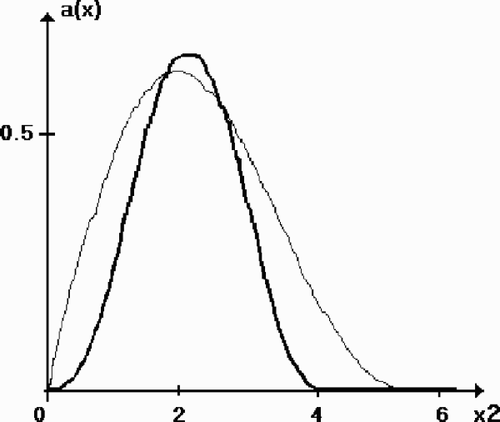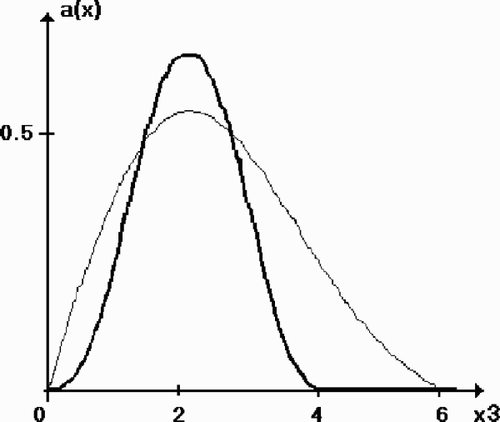Abstract
In this article we present a class of iterative methods for the inverse problem of 3D acoustic scattering on a penetrable inhomogeneity. We formulate the problem as an ill-posed nonlinear operator equation in a Hilbert space. The proposed methods are based on an approximation of this equation by a strongly convex finite-dimensional variational problem. The strong convexity of the approximating problem plays the key role in a theoretical justification of our approach to numerical approximation of solutions to ill-posed problems. Specifically, this property ensures the stability of the proposed iterative methods with respect to the errors in input data as an iteration number increases. We also present results of computational experiments.
1. Problem formulation
This article is concerned with a numerical analysis of the inverse medium scattering problem for acoustic waves. The problem is to determine a refractive index of an inhomogeneous medium from the measurements of far-field patterns of scattered time-harmonic acoustic waves.
We work with the classical model of time-harmonic acoustic scattering on an inhomogeneity Citation[1, Ch. 8]. Assume that a 3D homogeneous acoustic medium consists of a penetrable inhomogeneous inclusion localized within a bounded open subset B ⊂R3. Acoustical properties of the medium are characterized by the sound speed c(x) > 0, x∈ R3. Assume that the sound speed outside B is a given constant c0 : c(x) = c0 , x ∈ R3\B. Therefore the medium can be described by the refractive index
(---203---1)
Suppose n belongs to the Sobolev space Hs (B) with s > 3 / 2. For an introduction to Sobolev spaces, we refer to Citation[2]. By the embedding theorem, n(x) satisfies the Hölder condition:
(---203----1) for all x, y ∈ B with L0 > 0 and an appropriate α independent of x, y. The scattering of an incident time-harmonic plane wave with the complex amplitude
(---203----2) is described by the equations
(---203--1)
(---203---2)
and the Sommerfeld radiation condition
(---203--2)
where x · y stands for the scalar product of vectors x, y ∈ R3, k > 0 is the wavenumber fixed throughout the article,
(---203----3) R3:
(---203----4) is the direction of motion of the incident wave, and u(x, d) and us (x, d) are complex amplitudes of the full and scattered wave field, respectively. The Sommerfeld condition guarantees that the scattered wave is outgoing. In the direct scattering problem, the refractive index n = n(x), x ∈ B is given and the full wave field u(x, d) or the scattered field us (x, d), x ∈ R3 is to be evaluated. It is well known (see Citation[1, Ch. 8]) that this problem has a unique solution. Moreover, for the scattered field the following asymptotic representation is valid Citation[1, p. 222]
(---203--3)
The factor
(---203----5) in Equation(3)
(---203--3) is called the far-field pattern or the scattering amplitude of us (x, d) and the unit vector
(---203----6) is the direction of observation of us (x, d). Denote a(x) = 1 − n(x), then we obviously have a(x) = 0 for x ∈ R3\B and
(---203----7) .
The inverse medium acoustic scattering problem is to determine the refractive index (---203----8) or, equivalently, the function
(---203----9) given the scattering amplitudes
(---203----10) for all directions d ∈S2 of incoming plane waves. Hence the input data of the problem under consideration are the values
(---203----11) for all
(---203----12) . It can be shown Citation[1, p. 278] that the inverse acoustic problem in this setting has a unique solution, i.e., the refractive index n(x) is uniquely determined by the knowledge of the far-field patterns
(---203----13) .
Recall that the direct scattering problems Equation(1)(---203--1) and Equation(2)
(---203--2) is equivalent to the Lippmann–Schwinger equation Citation[1, p. 216]
(---203--4)
where
(---203---3)
is the fundamental solution of the Helmholtz equation in a homogeneous space (n(x) ≡ 1, x∈R3) subject to the Sommerfeld condition Equation(2)
(---203--2) . Multiplying both the parts of Equation(4)
(---203--4) by a(x), as in Citation[3] we come to the equality
(---203--5)
where
(---203----14) . With the use of notation
(---203---4)
we can rewrite Equation(5)
(---203--5) as
(---203---5)
where I stands for the identity operator and a denotes the operator of multiplication by a(x). It is easily seen that if v(x, d) solves Equationequation (5)
(---203--5) then the function
(---203----15) satisfies Equation(1)
(---203--1) and Equation(2)
(---203--2) . Since by Equation(4)
(---203--4) ,
(---203---6)
for the scattering amplitude
(---203----16) we then have the representation Citation[1, p. 223]
(---203--6)
where the operator E is defined by the equality
(---203---7)
Combining Equation(5)
(---203--5) and Equation(6)
(---203--6) , we come to the following nonlinear equation for the unknown function a(x), x ∈B
(---203--7)
It is well known Citation[1, Ch. 10] that Equationequation (7)(---203--7) is an ill-posed problem for each reasonable choice of the solution space and the space of right-hand side in Equation(7)
(---203--7) . This problem is usually studied in the Lebesgue space L2 , Sobolev spaces
(---203----17) , or the spaces of smooth functions
(---203----18) . The ill-posedness of Equation(7)
(---203--7) means that arbitrarily small variations of the scattering amplitudes
(---203----19) can lead to significant changes in solution a(x) or can even transform Equation(7)
(---203--7) into an equation that has no solutions at all. Hence for stable numerical approximation of a solution to Equation(7)
(---203--7) one should use regularization methods (see, e.g., Citation[4–Citation6]). A widely accepted class of such methods make up iterative regularization algorithms. Algorithms of this type are very attractive in practice because of the ease of their numerical implementation especially when a solution space of the problem is Hilbert space L2 . The monograph Citation[6] presents a number of iterative procedures for nonlinear ill-posed equations with smooth operators given with errors. However, the convergence of the methods of Citation[6] is established under rather severe conditions on the operators of equations. These conditions involve the first derivative of the operators and generalize the classical regularity condition, which says that the derivative must be continuously invertible. When applied to the inverse problems of potential theory and inverse acoustical problems including Equation(7)
(---203--7) , none of such conditions has been verified so far (see Citation[7–Citation9]). Moreover, on a solution space L2 , which is formally most convenient for numerical treatment, operators of applied inverse problems often possess fewer smoothness properties than are required by existing convergence theorems. In particular, these operators usually appear to be well defined not on the whole of the space of L2 -functions but on its subsets of continuous or smooth functions Citation[1, Chs. 5, Citation8]. This fact raises additional difficulties for rigorous theoretical justification of iterative solution methods for such inverse problems.
In the present article we propose a general scheme of constructing iterative methods for solving nonlinear ill-posed equations without any assumptions concerning the differentiability of their operators on open subsets of the solution space. The iterative points generated by the proposed methods are attracted to a small neighborhood of the solution. In other words, these methods appear to be stable with respect to the errors of input data. The stabilization of iterations is ensured by an appropriate finite-dimensional approximation of the original equation. We also give results of computational experiments with some of the proposed methods in application to the inverse acoustical problem described above. The article is organized as follows: in Section 2 we present a sketch of the abstract scheme and describe the proposed methods for solving Equation(7)(---203--7) ; Section 3 contains the results of our computational tests.
2. A class of iterative methods
In this section we consider the operator equation
(---203--8)
where
(---203----20) is a nonlinear operator and H1 , H2 are the Hilbert spaces. Fix arbitrarily an element ξ ∈H1 and choose a finite-dimensional subspace M ⊂ H1. The pair
(---203----21) will be used below for constructing a regular finite-dimensional approximation of the original problem Equation(8)
(---203--8) . We shall consider M as a Euclidean space endowed with the norm of H1. Let u* be a solution of Equation(8)
(---203--8) and PM be the orthoprojector from H1 onto M. Assume that
(---203--9)
The value Δ estimates an error of approximation of u* by the affine subspace Mξ , where
(---203---8)
Throughout the article, ‖·‖ H stands for the norm of a Hilbert space H; L(H1 , H2 ) is the Banach space of all linear bounded mappings from H1 into H2. We endow L(H1 , H2 ) with the standard norm
(---203---9)
No assumptions are made both on a differentiability of the operator F(u) in an open neighborhood of u* and on a continuous invertibility of the derivative F′(u) if F(u) is differentiable. Therefore, Equationequation (8)
(---203--8) represents a very general abstract model of applied ill-posed problems. Instead of the classical smoothness assumptions we impose on F(u) the weaker condition that
(---203---10)
and the operator
(---203---11)
is Fréchet differentiable with a Lipschitz continuous derivative, at least for points u ∈M from a neighborhood of
(---203----22) . More comprehensively, suppose that for some positive constants L = L(M) and R we have
(---203--10)
where by definition
(---203----23) . Also, suppose the operator
(---203---12)
is Fréchet differentiable at the point
(---203----24) and the derivative
(---203----25) satisfies the condition
(---203--11)
then the operators Φ ′(u) and Ψ′(u) are understood as linear continuous mappings from M into H2. Note that if F(u) appears to be differentiable on H1 then we have
(---203----26) and
(---203----27) . Let us impose on M the following additional restriction:
Assumption A The subspace M is chosen such that the linear operator (---203----28) is injective, i.e., one-to-one.
Assumption A implies that the operator F(u) must be regular as a mapping from (---203----29) into H2 but not necessarily from the whole of H1 into H2 as classical regularity assumptions require. In the case that F(u) is differentiable on an open neighborhood of u*, Assumption A simply means that F(u) is regular as a mapping from Mη into H2 for all points η ∈H1 sufficiently close to u*. In this situation it is obvious that Assumption A is valid for each subspace M ⊂ H1 if the operator
(---203----30) is injective. The last remark allows for the following generalization. Suppose
(---203----31) is a Hilbert or Banach space embedded into H1, the solution
(---203----32) , the operator
(---203----33) is differentiable on a neighborhood of u*, and the derivative
(---203----34) is injective. Then Assumption A is valid for each finite-dimensional subspace
(---203----35) . Let us remark that the operator F of the inverse medium scattering problem Equation(7)
(---203--7) satisfies the above listed conditions with the spaces
(---203----36) (s > 3 / 2), H1 = L2 (B), and
(---203----37) Citation[3]. This fact partially motivates the choice of Equation(7)
(---203--7) as an object of our computational experiments.
Also, Assumption A is valid if F(u) is continuously differentiable and there exists a point (---203----38) in a small neighborhood of u* such that Ker
(---203----39) , where Ker
(---203----40) .
The lack of standard differentiability and regularity properties of the operator F(u) rises the question of stable evaluation of u* especially when F(u) is given approximately. Let (---203----41) be an available approximation of F(u). Assume that
(---203----42) . Then instead of the true operator Φ (u) we have only its perturbation
(---203----43) . Suppose the operator
(---203----44) is Fréchet differentiable and the derivative
(---203----45) satisfies Equation(10)
(---203--10) and the following conditions:
(---203--12)
where δ has the meaning of an error level in
(---203----46) . Stable iterative methods that we intend to propose for solving Equation(8)
(---203--8) are based on approximation of the original Equationequation (8)
(---203--8) by the finite-dimensional variational problem
(---203--13)
Denote by ρ = ρ (M) > 0 the least eigenvalue of the operator
(---203---13)
and set
(---203---14)
where N = N(M), r = r(M). The following theorem establishes the main qualitative property of the functional
(---203----47) defined by Equation(13)
(---203--13) .
THEOREM 1 Let Assumption A and conditions Equation(9)(---203--9) –Equation(12)
(---203--12) be satisfied. Suppose
(---203--14)
Then the functional
(---203----48) is strongly convex on the finite-dimensional ball
(---203----49) . Moreover,
(---203----50) has a unique local minimum
(---203----51) with
(---203----52) , and the estimate is valid:
(---203--15)
This assertion is an immediate consequence of Theorem 3 from Citation[10]. Thus we see that if the conditions of Theorem 1 are satisfied then for practical minimization of (---203----53) over the finite-dimensional subspace M we can effectively use various iterative procedures, e.g., gradient processes, conjugate gradient methods, etc. (see, e.g. Citation[11,Citation12]). Since the functional
(---203----54) is locally strongly convex, most of these methods starting at a point u0 ∈M from a neighborhood of
(---203----55) generate sequences
(---203----56) such that
(---203----57) and
(---203----58) . Due to the strong convexity of
(---203----59) , rate of convergence estimates for these methods are also available Citation[11,Citation12]. We can now characterize asymptotic properties of the sequences {un} with respect to the solution u* of Equation(8)
(---203--8) .
THEOREM 2 Let assumptions of Theorem 1 be satisfied. Suppose
(---203--16)
and the initial point u0 ∈M satisfies
(---203--17)
Then the functional
(---203----60) is strongly convex on the level set
(---203---15)
Let {un} be a minimizing sequence for the functional (---203----61) such that
(---203---16)
with
(---203----62) specified in Theorem 1. Then for the elements
(---203----63) we have
(---203--18)
The proof of Theorem 2 follows directly from the proof of Theorem 4 Citation[10].
In order to clarify the statements of Theorems 1 and 2, let us assume as a preliminary that we have chosen and fixed the subspace M so that the value ρ = ρ (M) is a given constant. From Equation(14)(---203--14) and Equation(16)
(---203--16) it follows that the conditions of the theorems can be fulfilled only if the values Δ, Δ1, and
(---203----64) are sufficiently small. On the other hand, estimates Equation(15)
(---203--15) and Equation(18)
(---203--18) become more informative when Δ and
(---203----65) tend to zero. Since all these values depend on the choice of ξ, it is natural to consider Equation(9)
(---203--9) , Equation(11)
(---203--11) , and the inequality
(---203----66) with small Δ, Δ1, and Δ2 as restrictions imposed on the element ξ. The theorems then imply that if an initial approximation
(---203----67) is taken from a fixed neighborhood of
(---203----68) (see Equation(17)
(---203--17) ), then the sequence {vn} is attracted to a neighborhood of u* with diameter proportional to δ, Δ, and Δ2 . Specifically, if ξ is chosen such that Δ and Δ2 are of orderδ then Theorem 2 implies the stabilization of vn in a neighborhood of diameter O(δ) while the starting point is taken arbitrarily from a ball of diameter O(1). For example, if ξ = ξ* satisfies
(---203----69) then we get
(---203----70) , and conditions Equation(14)
(---203--14) are equivalent to the upper bound of the error level:
(---203----71) . In this case, Equation(18)
(---203--18) takes the form
(---203---17)
and hence the iterations vn , n →∞ are attracted to a neighborhood of the solution u* with a diameter of orderδ. Although we have no rigorous algorithm for finding ξ*, inequality Equation(18)
(---203--18) shows that in a general situation when
(---203----72) but Δ and Δ2 are small, the sequence {vn} (n →∞) behaves similarly provided that conditions Equation(14)
(---203--14) , Equation(16)
(---203--16) , and Equation(17)
(---203--17) are satisfied. To ensure these conditions, all available a priori information concerning the solution u* should be used. An algorithmic implementation of possible approaches to construction of (ξ , M) following by one or another volume of a priori information remains an open problem. Also, note that each algorithm that generates parametric families
(---203----73) with the properties
(---203---18)
defines a regularization algorithm for the original equation Citation[4–Citation6]. Given the error levelδ this algorithm takes each approximate operator
(---203----74) to the element
(---203----75) specified in Theorem 1. Then by Equation(15)
(---203--15) we have
(---203---19)
In view of the first condition from the listed above, it is likely that the family {M(δ)} must be chosen such that (---203----76) although formally speaking the increase of dim M(δ) is not necessary, since all the conditions can be in principle satisfied by a suitable choice of a position of a low-dimensional subspace M(δ) in H1. Observe that variations of the parameter ξ (δ) provide additional means for minimization of
(---203----77) .
Let us describe an abstract scheme of constructing stable iterative methods for Equationequation (8)(---203--8) . First, pick a subspace M ⊂ H1 satisfying Assumption A. Then using an available a priori information concerning u*, choose an element ξ ∈H1 such that
(---203----78) and inequalities Equation(9)
(---203--9) , Equation(11)
(---203--11) , and
(---203----79) are valid with small Δ, Δ1, and Δ2 . Next, an iterative method for minimization of the locally strongly convex functional
(---203----80) should be fixed. According to Equation(18)
(---203--18) , the iterations
(---203----81) , where un are generated by the method, will be attracted to a neighborhood of u* with diameter of order O(δ+ Δ+ Δ2 ).
For solving Equation(13)(---203--13) various gradient-type procedures and other classes of iterative methods are applicable. As examples we only point at the well-known gradient iterations
(---203--19)
with a constant stepsize γ > 0 and Fletcher and Reeves' conjugate gradient method Citation[11, Ch. 8]
(---203--20)
where γn > 0 is defined by the equality
(---203---20)
and the direction pn is constructed in the form
(---203---21)
Remark 1 In the case that D(F) = H1and the operator F(u) is differentiable on the whole of H1, asymptotic properties of the process Equation(19)(---203--19) and its variants were studied in Citation[13, Ch. 5].
Remark 2 Theorems 1 and 2 remain valid if the condition (---203----82) is relaxed as follows:
(---203---22)
Concluding this section, we point out that for solving Equation(13)
(---203--13) some continuous analogs of classical iterative methods are also applicable. Among others we can use the gradient process
(---203--21)
which is the limit form of the iterations Equation(19)
(---203--19) as γ→0. From Theorem 1 it follows that if the initial point u0 is sufficiently close to
(---203----83) then the stationary point
(---203----84) of the finite-dimensional dynamical system Equation(21)
(---203--21) is asymptotically stable and there exist constants C, ω > 0 such that
(---203---23)
Due to Equation(15)
(---203--15) , for elements
(---203----85) we have the estimate
(---203---24)
If the operator
(---203----86) is differentiable on an open neighborhood of u* then Equation(21)
(---203--21) takes the form
(---203--22)
The process Equation(22)(---203--22) can be considered as a continuous analog of the iterative methods recently studied in Citation[13, Ch. 5].
In the next section we apply iterations Equation(19)(---203--19) and Equation(20)
(---203--20) to the inverse medium scattering problem presented in Section 1.
3. Application to the inverse scattering problem
We are now ready to present several stable iterative methods for the Equationequation (7)(---203--7) . In order to write Equation(7)
(---203--7) in the form of Equation(8)
(---203--8) , define the operator
(---203---25)
where
(---203--23)
Suppose (---203----87) is a parallelepiped containing the inhomogeneity of the medium. For solving Equation(8)
(---203--8) with the operator Equation(23)
(---203--23) the processes Equation(19)
(---203--19) and Equation(20)
(---203--20) are applicable. We take
(---203----88) ; as we choose M as the subspace of trigonometrical polynomials
(---203--24)
Denote by a* (x) the solution of Equation(7)
(---203--7) so that n* (x) = 1 − a* (x) is the unknown refractive index of the inhomogeneity. Assume that instead of the true scattering amplitudes
(---203----89) , some of their approximations
(---203----90) are available. Thus the approximate operator
(---203----91) has the form
(---203---26)
As in Citation[3], it can be easily shown that if the value (---203----92) is sufficiently small then with some ϵ > 0 we have
(---203---27)
and the Fréchet derivative Φ′(a) is Lipschitz continuous for all a from the neighborhood
(---203----93) . Assumption A in this context is also satisfied since
(---203----94) (s > 3 / 2) is an injective operator (see Proposition 2.2 in Citation[3]), and
(---203----95) . Using the representation
(---203---28)
we can rewrite Equation(13)
(---203--13) as the finite-dimensional optimization problem
(---203---29)
where
(---203--25)
Here |z| stands for the modulus of z ∈ C. For evaluating the partial derivatives (---203----96) in Equation(19)
(---203--19) and Equation(20)
(---203--20) we used the standard finite-difference scheme
(---203---30)
with h = 10 − 3. When implementing the iterations Equation(19)
(---203--19) and Equation(20)
(---203--20) , we need to solve the direct scattering problem Equation(5)
(---203--5) several times per iteration. In our tests the Equationequation (5)
(---203--5) was solved by the simple iteration process
(---203--26)
In all experiments the function (---203----97) was approximated by 8 iterations Equation(26)
(---203--26) with the stepsize λ = 0.5.
In order to define the functional Equation(25)(---203--25) completely it suffices to specify the parameter
(---203----98) . The best possible choice is evidently
(---203---31)
with an arbitrary ς ∈M(N), but it is unlikely that any algorithmic ways to determine such ξ exist. Nevertheless, if the unknown solution a* (x)allows for a satisfactory approximation by the trigonometrical polynomials Equation(24)
(---203--24) then we can simply put ξ = 0. This is precisely the choice that we followed in our computational experiments.
We studied the model inverse scattering problem with the known exact solution n* (x) = 1 − a* (x), where
(---203---32)
B0 = (0, 4) × (0, 4) × (0, 4) is a domain actually containing the inhomogeneity and B = (0, 6) × (0, 6) × (0, 6) is a given domain of R3 where the inhomogeneity a priori lies. The directions of observation
(---203----99) and directions of incident waves d = d(j) ranged over the set of 14 directions
(---203---33)
“uniformly” distributed over the sphere S2 . The numerical integration over S2 × S2 in Equation(25)
(---203--25) was performed by the scheme
(---203---34)
with m = 14 and
(---203----100) . To integrate over the parallelepiped B we chose the 3D Gauss scheme with 8 knots by each coordinate. In all the tests we put k = 1 and
(---203----101) so that the unknown function
(---203----102) was approximated directly by the functions
(---203----103) generated by Equation(19)
(---203--19) or Equation(20)
(---203--20) . The initial approximation was
(---203----104) . Possible errors in input data
(---203----105) were simulated by additive random perturbations. More precisely, in Equation(25)
(---203--25) we used the noisy data
(---203---35)
where ω(ij) are realizations of a random variable uniformly distributed on the interval [ − 1,1]. Let us now describe the obtained numerical results. By
(---203----106)
(---203----107) we denote the discrepancy at the nth iteration.
Test 1 In the first experiment 160 iterations of the gradient process Equation(19)(---203--19) , Equation(23)
(---203--23) , and Equation(24)
(---203--24) were performed with the following values of parameters:
(---203----108) . presents the profiles of the exact function
(---203----109) (bold line) and the reconstructed function
(---203----110) (thin line). The initial discrepancy was r0 = 0.19 while at the 160 th iteration we obtained r160 = 0.04.
Figure 1. Test 1: the original function and the reconstruction a160 (x1 , 2, 2). The level of noise δ = 0.
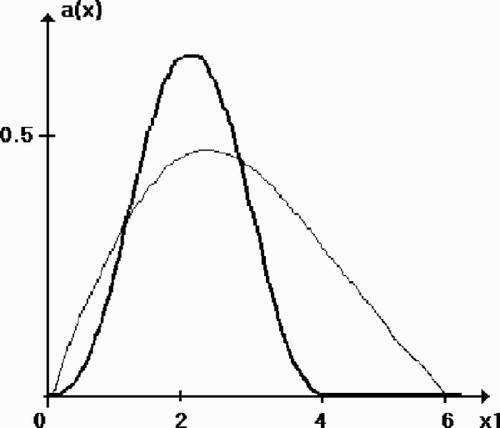
– present a result of 160 iterations of the same process with the maximal level of noise δ = 0.01. The original and reconstructed functions (---203----112) are shown in ; and present the exact and reconstructed functions
(---203----113) and
(---203----114) respectively. In this case we had r0 = 0.22 and r160 = 0.11.
Figure 2. Test 1: the original function and the reconstruction a160 (x1 , 2, 2). The level of noise δ = 0.01.

Figure 3. Test 1: the original function and the reconstruction a160 (2, x2 , 2). The level of noise δ = 0.01.
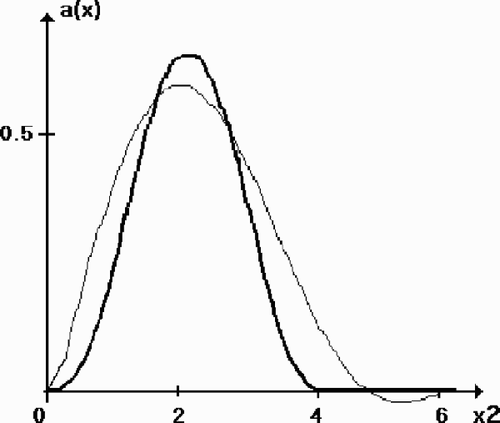
Figure 4. Test 1: the original function and the reconstruction a160 (2, 2, x3 ). The level of noise δ = 0.01.
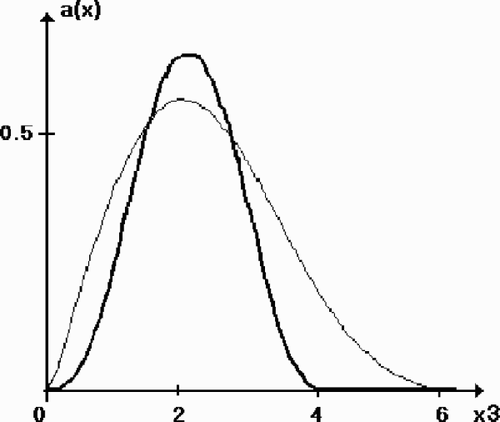
Test 2 In the second test we used the conjugate gradient method Equation(20)(---203--20) , Equation(23)
(---203--23) , and Equation(24)
(---203--24) with
(---203----118) . First, 40 iterations of the method were performed with δ = 0. We obtained r40 = 0.04. In the exact function
(---203----119) (bold line) and the reconstructed function
(---203----120) (thin line) are shown. Then, 40 iterations of the same process were performed with δ = 0.01. We obtained r40 = 0.11. – present the exact solution and the reconstructed functions
(---203----121) ;
(---203----122) , and
(---203----123) obtained in the case of noisy data.
The analysis of – shows that the methods Equation(19)(---203--19) and Equation(20)
(---203--20) give qualitatively good results in all the cases considered.
In Citation[1,Citation3,Citation14]the interested reader will find several alternative solution methods for inverse medium scattering problems as well as results of corresponding computational experiments.
Acknowledgment
This work was supported by RFBR, project No 03–01–00352.
- Colton, D, and Kress, R, 1998. Inverse Acoustic and Electromagnetic Scattering Theory. Berlin. 1998. p. p. 334.
- Adams, R, 1975. Sobolev Spaces. New York. 1975. p. p. 268.
- Hohage, T, 2001. On the numerical solution of a three-dimensional inverse medium scattering problem, Inverse Problems 17 (2001), pp. 1743–1763.
- Tikhonov, AN, Leonov, AS, and Yagola, AG, 1998. Nonlinear Ill-posed Problems. V.1 and V.2. London. 1998. p. p. 387.
- Bakushinsky, A, and Goncharsky, A, 1994. Ill-posed Problems : Theory and Applications. Dordrecht. 1994. p. p. 258.
- Engl, H, Hanke, M, and Neubauer, A, 1996. Regularization of Inverse Problems. Dordrecht. 1996. p. p. 321.
- Hettlich, F, 1998. The Landweber iteration applied to inverse conductive scattering problems, Inverse Problems 14 (1998), pp. 931–947.
- Hettlich, F, and Rundell, W, 1996. Iterative methods for the reconstruction of an inverse potential problem, Inverse Problems 12 (1996), pp. 251–266.
- Hohage, T, and Schormann, C, 1998. A Newton-type method for a transmission problem in inverse scattering, Inverse Problems 14 (1998), pp. 1207–1227.
- Kozlov, AI, 2002. A class of stable iterative methods for solving nonlinear ill-posed operator equations, Advanced Computing. Numerical Methods and Programming 3 (2002), pp. 180–186, Sec. 1.
- Bazaraa, MS, and Shetty, CM, 1979. Nonlinear Programming. Theory and Algorithms. New York. 1979. p. p. 560.
- Dennis, JE, and Schnabel, RB, 1983. Numerical Methods for Unconstrained Optimization and Nonlinear Equations. New Jersey. 1983. p. p. 378.
- Bakushinsky, AB, and Kokurin, Yu., M, 2002. Iterative Methods for Solving Ill-posed Operator Equations with Smooth Operators. Moscow. 2002. p. p. 192.
- Kleinman, RE, and van den Berg, PM, 1992. A modified gradient method for two-dimensional problems in tomography, Journal of Computational and Applied Mathematics 42 (1992), pp. 17–35.


